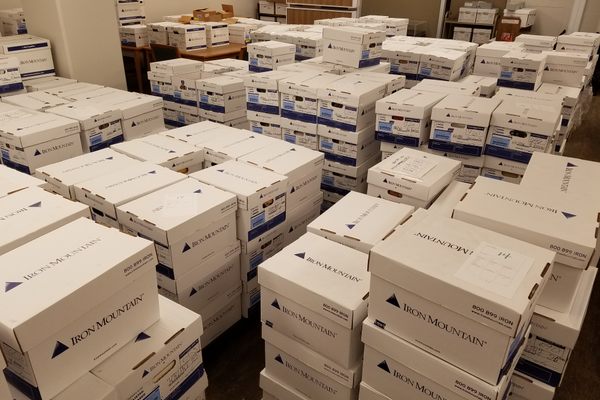The Folger Shakespeare Library Will Lend Chilly Readers a Handmade Shawl
The reading room’s head of circulation has created an informal lending library of coziness.

In the reading room of the Folger Shakespeare Library in Washington, D.C., researchers might spend hours carefully paging through a 16th-century pamphlet or the only surviving quarto edition of Titus Andronicus. (“If one good deed in all my life I did, I do repent it from my very soul.”) But they also have access to another unusual—if more informal—collection. Behind the reading room desk there is a vault where the staff keeps a small lending library of handmade shawls.
Three of the shoulder coverings are knitted and two crocheted. The blue one is longer and lighter; the brown one, the newest addition, has pockets. One circular shawl has rings of different colors, and another with light, spring colors is a little bit thicker and larger. The original shawl, the one that started the collection, is a sandy brown. All five are the work of Rosalind Larry, the room’s head of circulation, who made them, often on her lunch hour, during her many years at the library.
Larry started knitting the first shawl in the 1980s, after the library was remodeled and the reading room expanded. Not long before, she had seen a colleague making baby booties and thought she might like to learn to knit. “She showed me how, and at first I was terrible at it,” Larry says. But soon she grew more ambitious, and when she had some yarn she wanted to use up, she thought she might make herself a shawl, since it always felt cold in the reading room.

“That was a learning experience, knitting that shawl,” she says. It was a repeating pattern, on a circular needle—a challenging project for someone still learning to knit. “Finally, I got the hang of it. It worked out fine.”
Larry wore her new creation as a shawl or lap rug, and found herself often lending it to chilly colleagues or readers. The temperature and humidity in the reading room have to be kept within a certain range to protect the rare books studied by researchers and other sensitive materials stored there. And because the reading room consists of two high-ceilinged spaces connected by a large opening, it’s difficult to control the temperature. “One room will get warm and the other will get cold,” says Larry. (Or, as one recent patron put it, “absolutely freezing.”) When the air circulators turn on, they sweep a cold draft through the room.
The library’s regulars know to bundle up, but other readers may not be prepared to layer. Seeing how much use her original shawl had gotten, Larry started building a small collection by knitting or crocheting through her lunch hour. “For me, it’s just a way of relaxing,” she says. “It’s my little way of trying to be creative.”

Now, if a librarian notices a shivering, underdressed patron, she might offer them one of Larry’s shawls, and another reader might inquire if there’s another available. One time, Larry recalls, someone stayed for almost a month and used the same shawl every day: “I’ll have my books and the shawl!” Repeat researchers often ask if they can use the same one they wore last time they were at the library.
So far, the collection of five shawls has met the demand. On a typical day, there could be 15 or 20 people in the reading room and, as far as Larry knows, all five shawls have never been in use at once. She has no plans to add to the collection, but it’s always possible she’ll have some extra yarn she needs to use up.




























Follow us on Twitter to get the latest on the world's hidden wonders.
Like us on Facebook to get the latest on the world's hidden wonders.
Follow us on Twitter Like us on Facebook